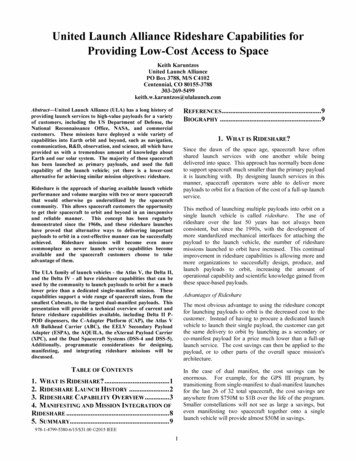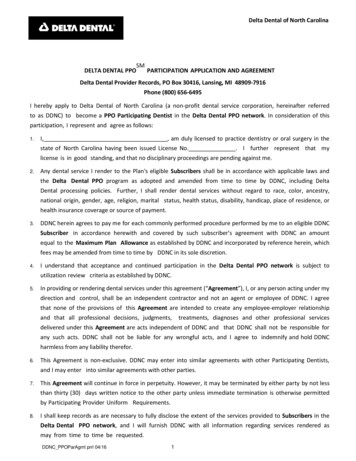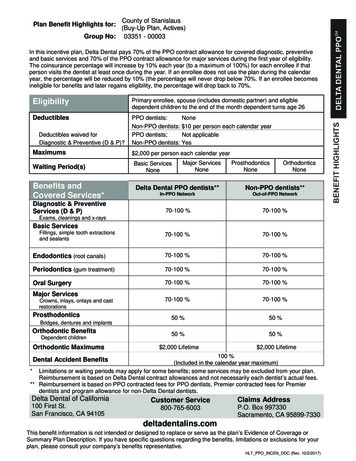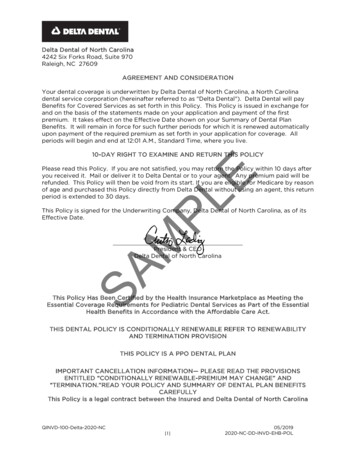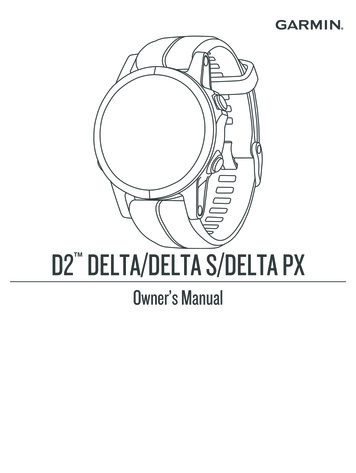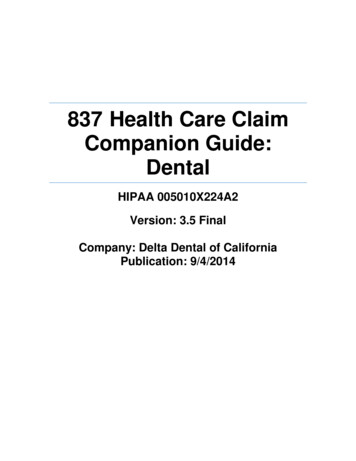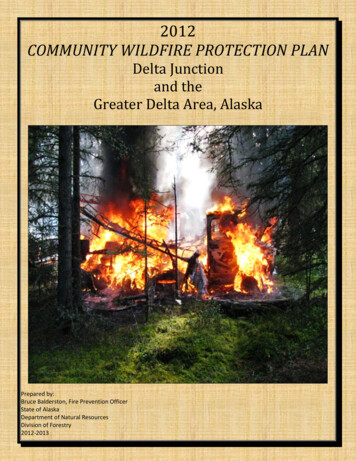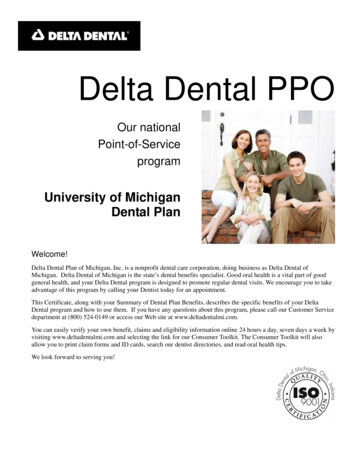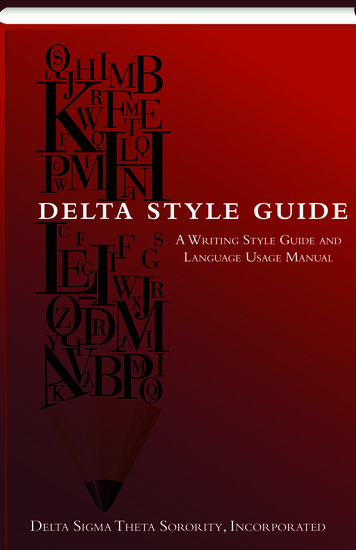
Transcription
D e lta Sty le G UID EA Writing Style Guide andLanguage Usage ManualDelta Sigma Theta Sorority, Incorporated1
Delta Style GuideA Writing Style Guide and Language Usage ManualDelta Sigma Theta Sorority, IncorporatedFirst edition: Sisterly Yours (2004) created by Doris McEwen, Ph.D.National Secretary 2002–06Revised 2014 by the National Information and CommunicationsCommittee and National Documents Review and Revision Task Force
ContentsAbout Delta Sigma Theta Sorority, Incorporated . . . . . . . . . . . . . . . . . . . . . . . .1Message from the National President . . . . . . . . . . . . . . . . . . . . . . . . . . . . . . . . . . 2Message from the National Information andCommunications Committee . . . . . . . . . . . . . . . . . . . . . . . . . . . . . . . . . . . . . . . . . 3How to Use the Style Guide. . . . . . . . . . . . . . . . . . . . . . . . . . . . . . . . . . . . . . . . . . .5Delta Words and Phrases . . . . . . . . . . . . . . . . . . . . . . . . . . . . . . . . . . . . . . . . . . . . . 7Common Words and Phrases . . . . . . . . . . . . . . . . . . . . . . . . . . . . . . . . . . . . . . . . . . .14Social Media . . . . . . . . . . . . . . . . . . . . . . . . . . . . . . . . . . . . . . . . . . . . . . . . . . . . . . . 38
About Delta Sigma Theta Sorority,IncorporatedNational Executive CommitteeDr. Paulette C. WalkerNational PresidentBeverly E. SmithNational First Vice PresidentCheryl A. HickmonNational SecretaryBrittani N. BlackwellNational Second Vice PresidentTerri E. Rivalte, CPANational TreasurerDelta Sigma Theta Sorority, Incorporated1707 New Hampshire Avenue, N.W.Washington, DC 20009(202) 986-2400deltasigmatheta.orgRoseline McKinneyExecutive Director/DSTinc1913@DSTinc19131DSTinc1913
Message from the National PresidentDear Sorors,I am pleased to present to you Delta Sigma Theta Sorority, Incorporated’supdated Delta Style Guide.This guide should be an important tool when youare communicating across the globe about our illustrious sisterhood.Since our founding in 1913, Deltas have contributed greatly to thecommunities we serve. Our goal is to build on our success by effectivelycommunicating our purpose, our plans and our progress. We can only do thatif we are consistent in our communication, sharing the same message — inthe same way — about who we are, why we exist, what our plans are for thefuture and what we’ve accomplished around the world. To achieve that goal,we must arm each and every soror with the right communications tools,beginning with this guide.Our National Information and Communications Committee has worked todevelop this document, keeping in mind the ideals of our Sorority and thetenets of journalism. I appreciate the committee’s expertise and the foundationprovided by the creator of the first Delta Style Guide, Doris McEwen, Ph.D.I would like to thank the National Documents Review and Revision TaskForce and National Headquarters Programs, Public Relations and Publicationsstaff for their valuable input as well.Sorors, we are embarking on our next 100 years. Let’s make sure we areconsistent in telling the story of the impact we have on the communities weserve.In service, leadership and empowerment,Paulette C. WalkerDr. Paulette C. WalkerNational President and CEO2
Message from the National Informationand Communications CommitteeDear Sorors,Thank you for reading Delta Sigma Theta Sorority, Incorporated’s revisedstyle guide and language usage manual.The style guide is for all Deltas, whether you are an individual contributor toyour chapter, the member of a committee or a soror charged with generatingpublicity for the Sorority.You will find two main sections in this manual. One section is devoted towriting related to Delta words and phrases. The other section is similar toThe Associated Press (AP) Stylebook, the newspaper industry standard usedby print journalists, broadcasters and public relations firms. For additionalwriting references, please consult the AP Stylebook, which can be found inprint, electronically or by subscription at www.apstylebook.com.Special thanks to Doris McEwen, Ph.D. National Secretary (2002-06), fordeveloping the original Delta Style Guide known as Sisterly Yours. Also,the committee would like to thank our National President, Dr. Paulette C.Walker, for understanding the importance of having an updated style guide toeffectively communicate our brand in the second century of our sisterhood.We appreciate the guidance provided by the National Headquarters staff,especially Sorors Ella McNair, Bernadine Stallings and E. Missy Daniels. And,we would be remiss if we didn’t thank the National Documents Review andRevision Task Force, led by Sorors Sandra K. Parker and Carol E. Ware, andour DRRTF liaison, Gwendolyn Mosley.Sorors, we’re grateful you picked up this manual. With your help, we canensure people throughout the world have a clear understanding of ourSorority’s contributions well into the future.Yours in Delta,Erica D. Donerson, ChairNational Information and Communications Committee3
National Information andCommunications Committee 2013-15Erica D. Donerson, ChairAlveta EwellRita Holmes-BoboMinnie Newbern JonesVivian KingDarrya LipscombJoi-Marie McKenzieKanika McKersonShanté Morgan-DurisseauDawn StrobertLillian Paige TurnerValerie WardlawLibra WhiteAiyana WilliamsStephanie Yelder-StovallNational Headquarters StaffElla McNair, Director of Programs/Publications & Public RelationsBernadine Stallings, Publications & Communications SpecialistE. Missy Daniels, Publications & Public Relations SpecialistPlease direct any questions or suggestions regarding the Delta StyleGuide to the National Information and Communications rg.4
How to Use the Style GuideWho should use the Delta Style Guide?Chapter JournalistsChapter PresidentsCommittee ChairsCorresponding SecretariesPublicity/Public Relations ChairsWebmastersEvery sororWhat is the Delta Style Guide?This is a writing guide with three sections: Delta Words and Phrases, CommonWords and Phrases, and Social Media.Delta Words and PhrasesProvides an explanation of how to write words and phrases used primarily bymembers of Delta Sigma Theta Sorority, IncorporatedCommon Words and PhrasesHighlights commonly used words and phrases in a format similar to TheAssociated Press (AP) StylebookSocial MediaExplains how to follow Delta Style when posting messages on social mediachannelsWhy use the Delta Style Guide?To ensure consistency in the Sorority’s communications5
How?Here are some examples of how to use this style guide.Style Guide EntriesFounders Day: Founders Day is always capitalized without an apostropheafter the “s.”If you’re looking forinformation on Founders Day,go to the Delta Words andPhrases section and look under“F” for Founders Day.Academic degreesUse an apostrophe in bachelor’s degree, a master’s, etc., but there is nopossessive in Bachelor of Arts or Master of Science.To find information aboutacademic degrees, go to theCommon Words and Phrasessection and look under “A”for academic degrees.6
Delta Words and Phrases7
Delta Words and PhrasesBelow are some helpful Delta writing style and grammar tips.Alumnae: Plural of alumna, which means a female graduate. Delta SigmaTheta Sorority, Incorporated refers to its graduate chapters as alumnaechapters, not alumni chapters. “Alumnae” is pronounced [uh-luhm-nee] andrhymes with “a gum tree.”Biennial: This means happening every second year. In Delta, there arebiennial conventions, not biannual, which means twice a year.Capitalization:Always capitalize the following:DeltaDelta Sigma Theta Sorority, IncorporatedFoundersFounders DayGrand ChapterHonorary Member(s)National Executive BoardNational Executive CommitteeNational HeadquartersNational PresidentNational First Vice PresidentNational Second Vice PresidentNational SecretaryNational TreasurerPast National President(s)Sorority (when referring to Delta Sigma Theta Sorority, Inc.)Centennial: In 2013, Delta Sigma Theta celebrated its 100th year, also knownas its centennial year. Capitalize the word when describing Delta SigmaTheta’s Centennial Celebration. Use lowercase in referencing the Sorority’scentennial year.8
Chapter: Nearly 1,000 collegiate and alumnae chapters have been charteredthroughout the world. When writing about a specific chapter, capitalize allwords, for example, San Jose Alumnae Chapter. On second reference, youmay drop the word “chapter.” When describing a chapter, you do not need tocapitalize the word.Example:Milwaukee Alumnae is one of the many chapters of Delta Sigma Theta.Chapter President: Each of Delta’s chapters has a chapter president.Capitalize the title when it is introducing the president. For example, useChapter President Jane Doe, but Jane Doe, chapter president. Do not capitalize“chapter president” if it is not preceding the president’s name.Charter Members: Delta Sigma Theta charter members are those sororswho organize a chapter. They should not be confused with the 22 Foundersof Delta Sigma Theta Sorority, Inc. The term “charter members” should notbe capitalized unless used as a heading.Chapter Name: The chapter name comes before the Sorority’s name.Example:The Chattanooga Alumnae Chapter of Delta Sigma Theta Sorority, Inc.Commissions, Committees and Task Forces: If a specific team ismentioned, use initial caps.Examples:The chapter’s Membership Services Committee organized a reclamationactivity.The National Ritual and Ceremonies Commission presented a workshop.Delta: Capitalize all uses when referring to Delta Sigma Theta or a soror.Delta Days in the Nation’s Capital: The title of this annual event refers tothe capital city of the United States, not the building used by Congress.9
Executive Committee: Delta’s Executive Committee consists of thefollowing officers: National President National FirstVice President (no hyphenation, no abbreviation of First to 1st) National Second Vice President (no hyphenation, no abbreviation ofSecond to 2nd) National Secretary National TreasurerAlways capitalize Executive Committee.Five-Point Programmatic Thrust: The major programs of the Sororityare based upon these five principles. There is a hyphen between “Five”and “Point.” There is only one Thrust. The five points should be listed inalphabetical order. Economic Development Educational Development International Awareness and Involvement Physical and Mental Health Political Awareness and InvolvementFounders: Delta Sigma Theta has 22 Founders. Always capitalize the word“Founders.” Delta’s Founders should not be confused with charter memberswho organize a chapter.Founders Day: Founders Day is always capitalized without an apostropheafter the “s.”Grand Chapter: Delta’s Grand Chapter refers to the entire Sorority and isalways capitalized.Incorporated: Spell out incorporated in the first reference to the Sorority’sname. It is acceptable to abbreviate as Inc. in the second reference, but use thecomma before Inc.Member at large/member-at-large: When using as a noun, it is memberat large. However, when using as an adjective, it is member-at-large.Examples:A member at large has equal rights and privileges.The DELTA Journal was sent to all member-at-large sorors.10
National Convention: Capitalize national convention when referring to aspecific event, for example, 51st National Convention. Otherwise, use lowercase“national convention” or “the convention.” The national convention is neverreferred to as “Nationals.”National First Vice President and National Second Vice President:These titles are never hyphenated.National Headquarters: Delta’s National Headquarters is located inWashington, DC. National Headquarters is always capitalized. NationalHeadquarters is never referred to as “Nationals.”National President: Capitalize in all uses. On first reference, the NationalPresident’s preferred full name should always be used.Examples:First reference:o National President Paulette C. Walker led the meeting.o Dr. Paulette C. Walker, National President, entered the assembly.Second reference:o Dr. Walker is the keynote speaker for the Founders Day luncheon.o Soror Butler-McIntyre introduced the EMBODI participants.o The National President participated in the Project 13 initiative.The National President doesn’t receive a number until she leaves office.Example:The 23rd National President, Dr. Louise A. Rice, served two terms.Omega Omega: The term “Omega Omega” should always be capitalized.Past National President(s): Any reference should include the Past NationalPresident’s number followed by “National President” and her name.Example:24th National President Cynthia M.A. Butler-McIntyre“Past National President(s)” should always be capitalized.Do not use the number and “Past National President” together.Incorrect: 24th Past National President11
Regional Conference: Capitalize regional conference when referring to aspecific event. Do not capitalize when using the words in general. This rulealso applies for state clusters or conferences. The regional conference is neverreferred to as “Regionals.”Examples:I will be attending the regional conference in July.The Protocol and Traditions Committee is preparing for state clusters andconferences.It is time to register for the 45th Midwest Regional Conference.Delta Sigma Theta has seven regional conferences in one year; theSouthern Regional Conference took place in June.Regional Leadership Team: This should be “regional leadership team”unless it is used in conjunction with the region’s name, as in “SouthernRegional Leadership Team.” This is similar to the style for regional directorsand regions in general. If team members are being listed, the heading of“Regional Leadership Team” should be capitalized.Regions: Delta Sigma Theta Sorority, Inc. is comprised of seven regions: Central Region Eastern Region Farwest Region Midwest Region South Atlantic Region Southern Region Southwest RegionCapitalize region when it is describing a specific region, as above.Example:Delta has seven regions, and one of them is the Eastern Region, wherethe Sorority was founded.Rites of Passage: The term “Rites of Passage” should be capitalized.Example:There are three Rites of Passage.12
Soror: Soror should not be capitalized unless it is before a name.Examples:Soror Jane DoeJane Doe is a soror.The sorors gathered.Do not use soror on a mailing to address members of Delta Sigma ThetaSorority, Inc.Sorority: Capitalize when referring to Delta Sigma Theta Sorority, Inc. Donot capitalize when referring to sororities in general.13
Common Words and Phrases14
Common Words and PhrasesThis guide is based on The Associated Press Stylebook.Like the AP Stylebook, this section is organized like a dictionary.AA before HUse “a” before a pronounced “h”: a historian, a horse, a hysterical jokeUse “an” before an aspirated “h”: an hour, an honest manAbbreviationsIt is preferable to avoid abbreviations, except in tables, headlines and othersituations where space is limited. When an abbreviation is necessary, here aresome reminders:All capital letter abbreviations or acronyms do not take periods exceptwhen referring to nations, states, cities or people.Examples: DST, DDNC, DDUN, Delta GEMS and EMBODINames of organizationsNames of organizations should be spelled out on first reference. Ingeneral, do not follow an organization’s name with an abbreviation oracronym in parentheses or set off by dashes (legal documents are theexception). If an abbreviation or acronym would not be clear on secondreference without this arrangement, do not use it.Academic degreesUse an apostrophe in bachelor’s degree, a master’s, etc., but there is nopossessive in Bachelor of Arts or Master of Science.African AmericanDo not use a hyphen unless using the term as an adjective. The term isacceptable for an American person of African descent, but be careful not toapply it indiscriminately. For instance, Caribbean descendants generally referto themselves as Caribbean Americans. The term black is also acceptable.Follow an individual’s preference.15
AgesAlways use figures.Example:The student is 19 years old.Ages used as nouns or adjectives before a noun require hyphens.Examples:The Children’s Center is hosting a party for 3-year-olds today.The 24-year-old student ran for office.References to an age range or a decade require no apostrophes.Examples:The soror was in her 30s, not 30’s.She grew up in the 1950s, not 1950’s.a.m., p.m.Use “a.m.” and “p.m.” in lowercase, with periods. Do not use “:00” for hours.Avoid redundancies, such as 10 a.m. on Tuesday morning.See also Time of dayBBachelor of Arts/Bachelor of ScienceA bachelor’s degree or bachelor’s is acceptable in any reference.BiGenerally, no hyphen is used when writing bimonthly, bilateral or bilingual.BlindSee Disabled/Handicapped/ImpairedBook titlesSee Composition titles16
CCapitalizationCityCapitalize city as part of a proper name.Examples:Kansas City, New York City, Oklahoma CityLowercase elsewhere, including all “city of ” phrases.Examples:A California citycity governmentcity of Los AngelesDirectionsDirections are not capitalized if they refer to a compass direction. Theyshould be capitalized; however, if they refer to a region, are part of aproper name or denote a widely known section of a city or state. Whenin doubt, use lowercase.SeasonsAlways lowercase fall, spring, summer, winter and derivatives such asspringtime, unless part of a formal name.CenturyLowercase, spelling out numbers less than 10.Examples:The first centuryThe 20th centuryChildrenIn general, use the first and last name of a child on first reference. Callchildren 15 or younger by their first name on second reference. For ages 16and 17, use judgment, but generally go with the last name. Use the last namefor those 18 and older.17
ColonsCapitalize the first word following the colon if it begins a complete sentenceor is a proper noun.Examples:The goal was simple: Keep customers first.Three words best describe the day: wet, dreary, disappointing.Colons and semicolons are never enclosed within the ending quotationmarks unless they are part of the quotation.CommasUse commas to separate items in a simple series, but not before theconjunction.Example:The items on the chapter’s agenda included workshops, service projectsand upcoming meetings.However, use a comma before the conjunction if there is a possibility ofconfusion without it.Example:Among those attending the conference were the deans of social sciences,applied sciences and the arts, and humanities and the arts.Use a comma to separate a name and academic degree.Example:Paulette C. Walker, Ed.D.When used with quotation marks, commas and periods are always enclosedwithin the quotation marks.Example:“The parking lot is crowded,” she said. “I should have left home earlierto attend the Founders Day luncheon.”18
A comma is needed before the word “including.”Example:Six scholarship applicants met the criteria, including three years ofcommunity service involvement, enrollment in an accredited school andtwo years of work experience.Company, corporate, product namesIn general, follow the spelling and capitalization used by the company: eBay,iPod, MasterCard, Macintosh, Kmart.Use ampersands as the official company or product name dictates.Abbreviate Co. and Corp., and eliminate the comma before Inc. Whenreferring to Delta Sigma Theta Sorority, spell out Incorporated in the firstreference. It is acceptable to abbreviate as Inc. in the second reference, butuse the comma before Inc.Use “the” lowercase unless is it part of the company’s formal name.Examples:Procter & Gamble, Gannett Co., Microsoft Corp., the Kroger Co., theLos Angeles Times, The New York TimesAlthough graphic elements may be part of a company’s logo, in text neveruse typographic symbols or unusual fonts in a name, including exclamationpoints, quotation marks, plus signs, asterisks, bold type or italic type.Examples:Yahoo, Toys R Us, E-TradeIncorrect:Yahoo!, Toys“R”Us, E*Trade19
Composition titlesUse these AP Stylebook guidelines in reference to book titles, computergames, movies, operas, plays, poems, albums and songs, radio and televisionprograms, as well as the titles of lectures, speeches and works of art.Capitalize the principal words, including prepositions and conjunctions offour or more letters. Capitalize an article—the, a, an—or words of fewerthan four letters if it is the first or last word in a title. Put quotation marksaround the names of all such works except the Bible and books that areprimarily catalogs of reference material. Translate a foreign title into Englishunless a work is known to the American public by its foreign name.Examples:“A Song of Faith and Hope: The Life of Frankie Muse Freeman”“Roses and Revolutions”Reference works:Encyclopedia BritannicaMerriam-Webster’s Collegiate Dictionary, Eleventh EditionCompound modifiersWhen two or more words are used to express a single concept in modifyinga noun, they become compound modifiers. Compound modifiers are linkedwith hyphens.Examples:Long-term assignmentFull-scale investigationsSmall-business ownerPart-time or full-time workerAfrican-American women20th-century artAn exception may occur when two words are so commonly associatedtogether that no confusion would occur or if the word combination appearsafter a noun.Examples:He is a real estate agent.She works part time.20
Computer termsCapitalize the word Internet as a proper name to distinguish it from otherkinds of nets. It may also be referred to as the Net, also capitalized.Some of the spellings of Internet-related words below are aligned with the“AP Stylebook.”cyberspacedownloaddot-com (informal adjective)emailemojifirewallhome pagehyperlinkInternetInternet radiointranetIP address (Internet protocol address)Java (a trademark)listservloginlogofflogonMP3onlinescreen saverselfieURL (Uniform Resource Locator)World Wide Web (a proper name)the Web, website, webcast, webmasterAlways include a period at the end of a sentence even if a web address oremail address appears at the end.21
DDeafWhen referring to the community, capitalize.See Disabled/Handicapped/ImpairedDegreesSee Academic degrees under CapitalizationDelta Days in the Nation’s CapitalDisabled/Handicapped/ImpairedIn general, writers should avoid the terms “handicapped” and “impaired”and use the term “disability” when referring to limitations resulting froma person’s disability. When referring to the person with a disability, “peoplefirst” language should always be used, as in:a person with a disabilitya person who is blinda person who is deaf or hard of hearinga person with a cognitive disabilitya person who is unable to speaka person with a physical disabilitya person with a psychiatric disabilitya person who uses a wheelchairA person with a disability should never be described as having a disabilityunless that information is pertinent to what is being written. Avoid alldescriptive language that might lead a reader to believe the person is anobject of pity or a victim, such as “confined to a wheelchair,” “afflicted with”or “overcome their disability.”DoctorUse Dr. in first reference as a formal title before the name of an individualwho holds a doctor of dental surgery, doctor of medicine, doctor ofoptometry, doctor of osteopathy, or doctor of podiatric medicine degree.Example:Dr. Regina BenjaminIncorrect: Dr. Regina Benjamin, M.D.22
If appropriate in the context, Dr. also may be used on first reference beforethe names of individuals who hold other types of doctoral degrees. In thecase of the Sorority’s National Presidents and Past National Presidents, Dr.is appropriate on first reference in writing. However, keep in mind that thepublic primarily associates the word “doctor” with physicians.EEllipsesThe three dots represent omitted words or a pause in speaking. They arepreceded and followed by spaces.Example:She talked about the morning traffic, her previous vacation, her son’swedding plans and enough other topics to bore everyone.e.g.Meaning for example, it is always followed by a comma.EmailUse lower case and do not hyphenate.Example:For any questions regarding the event, please email the committee chair.FFarther, further“Farther” refers to physical distance.“Further” refers to an extension of time or degree.Examples:The house was farther down the road than she remembered.He asked what further side effects he could expect.Fewer, lessFewer applies to numbers and modifies a plural noun. Less applies toquantities and modifies a singular noun.Example:She now eats fewer meals and less candy.23
Fundraising, fundraiserIt is one word in all forms and uses. Do not hyphenate.HHeadlinesOnly the first word and proper nouns are capitalized.Follow story style in spelling, but use numerals for all numbers and singlequotes for quotation marks. Exception: use US, UK and UN (no periods) inall headlines.HispanicThe terms “Hispanic” and “Latino/Latina” can be interchangeably usedwhen referring to individuals from a Spanish-speaking land or culture orfrom Latin America. Usage varies depending on context and the audiencebeing addressed.HyphensIn type, hyphens are different from dashes. Hyphens are sometimes used toavoid ambiguity.Example:He recovered from financial collapse.He re-covered his sofa in gray leather.Never hyphenated: National First Vice President and National Second VicePresidentSee DashesIIdentityRacial, ethnic, sexual and gender identity is personal. Ethnicity is notsynonymous with race; gender is not synonymous with sex; and genderidentity is not synonymous with sexual orientation.Although labels should be avoided whenever possible, it is sometimesrelevant to the article, press release or report. In general, utilize the termpeople prefer to be called, especially when dealing with race and ethnicity.24
Sometimes the common conventions of language inadvertently containbiases toward certain populations, e.g., using “normal” in contrast tosomeone identified as “disabled.” It is important to be aware of how thechoice of terminology may come across to the reader, particularly if thereader identifies with the population in question.i.e.Abbreviation for the Latin id est or that is and is always followed by acomma.InternetSee Computer termsIts, it’sIts is a possessive pronoun, while it’s contracts “it is” or “it has.”Examples:Nothing can take its place.It’s a small world.It’s been good to know you.A simple way to determine which term is needed is to read the sentenceusing “it is.” If the sentence doesn’t make sense, its is needed, not it’s.JJargonAvoid the use of jargon, clichés and colloquialisms in communications. Copyfilled with technical “insider’s” language confuses and discourages readers.KKidsUse “children” unless referring to goats.25
LLatino/Latina“Latino” is the masculine word while “Latina” is the feminine. Latino canrefer to a mixed group of both genders. The terms “Latino/Latina” and“Hispanic” can be interchangeably used when referring to individuals froma Spanish-speaking land or culture or from Latin America. Usage variesdepending on context and the audience being addressed.Use specific nationalities when available.Examples:Bolivian, Colombian, Cuban, Mexican, Peruvian, Puerto RicanMMagazine namesSee Newspaper/Magazine/Journal namesMonthsAbbreviate Jan., Feb., Aug., Sept., Oct., Nov. and Dec. when used with aspecific date.Example:My birthday is Jan. 15.Spell out when used alone or only with a year.Example:January 1989 was the coldest month on record.When using a month, date and year, set off the year with commas.Example:June 6, 1944, was D-Day.Also see DatesMovie titlesSee Composition titles26
NNewspaper/Magazine/Journal namesAs stated in the AP Stylebook, capitalize “the” in a newspaper’s name ifthat is the way the publication prefers to be known. Do not place name inquotes.Example:Detroit Free PressThe New York TimesWhere the location is needed, but is not part of the official name, useparentheses.Example:The Huntsville (Ala.) TimesCapitalize the magazine or journal name, but do not place it in quotes.Lowercase “magazine” or “journal” unless it is part of the publication’sformal title. Check the masthead to confirm the formal name.Examples:DELTA JournalEbony magazineAlthough clever typographic elements may be part of a publication’snameplate, editorial content never uses graphic symbols or stylized fonts,including exclamation points, quotation marks, plus signs, asterisks, bold typeor italic type.Examples:the Cincinnati Enquirer, ESPN the Magazine, LifetimesIncorrect: The Cincinnati Enquirer, ESPN The Magazine, LIFETIMESNumbers and numerical referencesAs a general rule, numbers from one to nine should be spelled out; numbers10 and above should be left in numerical form. Use numerical figures;however, when referring to sections of a book, grade point average andscores.Examples:A GPA of 3.0An ACT score of 827
Spell out the word percent in text. Do not use the symbol “%” except intables and technical text.Example:More than 20 percent passed the test with a score of 85 or better.Spell out ordinal numbers (first, second, third) first through ninth. For the10th ordinal and above, use figures.Example:First, second, 10th, 23rd, 31stWhen describing money in text, do not include the decimal places forwhole dollars.Example:Tickets cost 5 for general admission, 3 for students and 2.50 forchildren under 12.When describing time, do not use minute placeholders for whole hours. Toavoid confusion, always use noon, not 12 p.m., to refer to middle of the day.Example:The program will run from 8 a.m. to noon, with a coffee break at 10:15 a.m.Telephone NumbersWhen writing telephone numbers, use parentheses around the areacode, a format that telephone companies have agreed upon for domesticand international calls.Examples:Call (313) 555-1200 for information.Call toll-free (800) 555-1468.Always inclu
communities we serve. Our goal is to build on our success by effectively communicating our purpose, our plans and our progress. We can only do that if we are consistent in our communication, sharing the same message — in the same way — about who we are, why we exist, what our plans are for the

